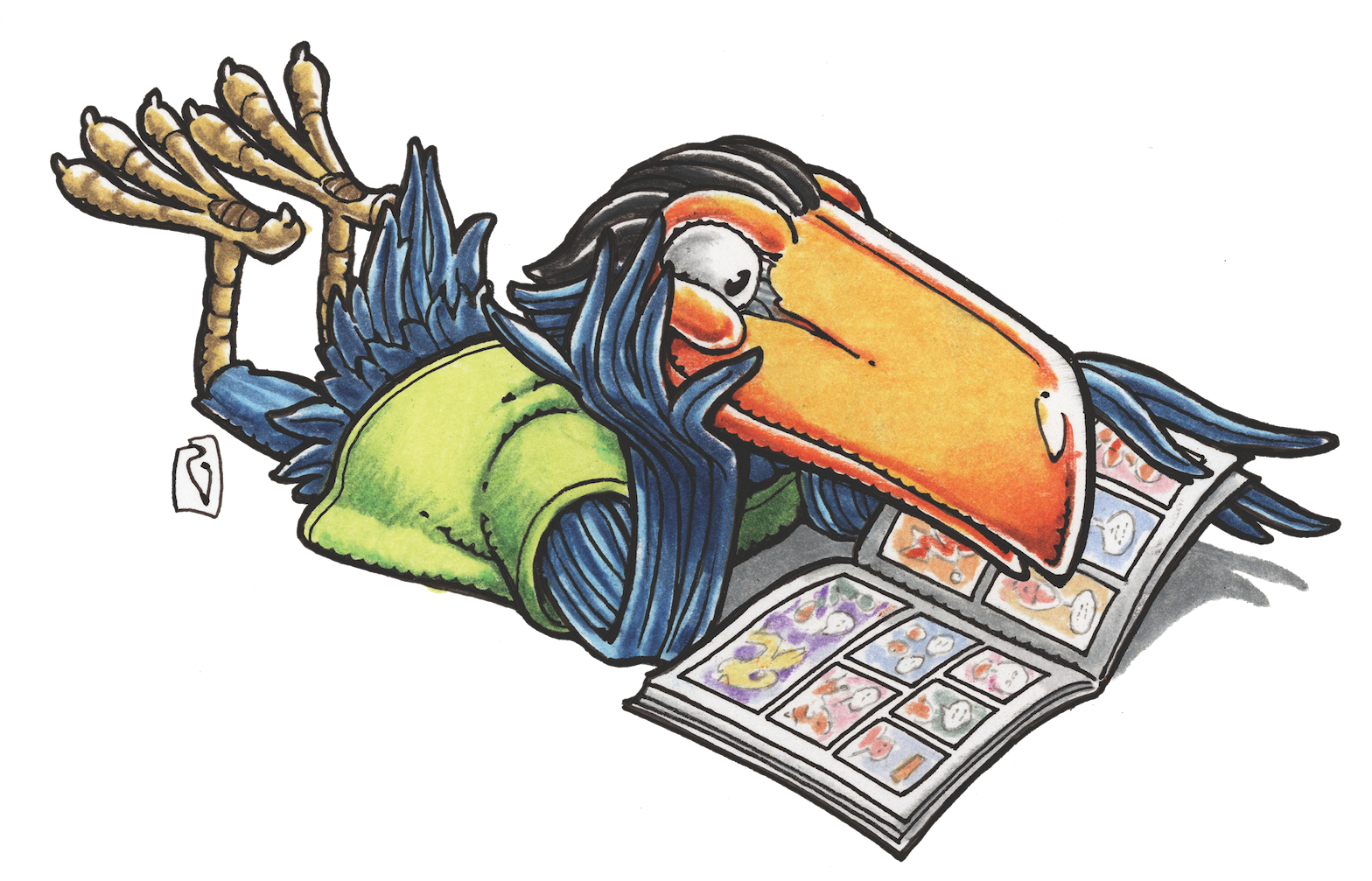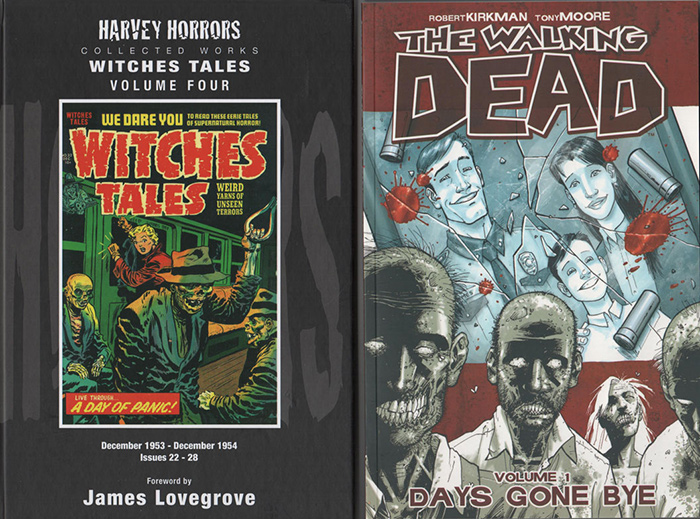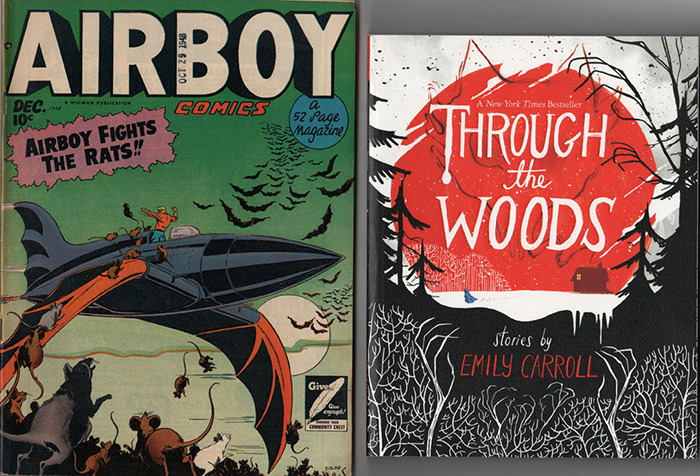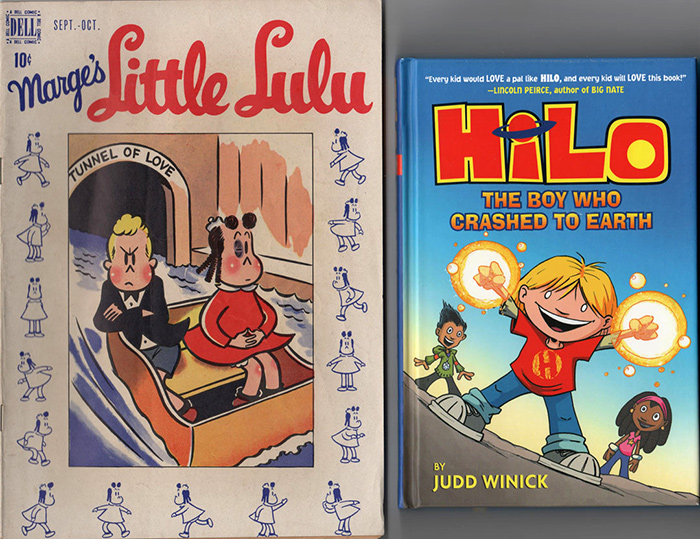MAGGIE’S WORLD BY MAGGIE THOMPSON
Maggie’s World 033: BOO!

Did you see the recent Blood Moon?
Did you just buy the DVD of the first season of iZombie, as the second season prepared to launch? Did you recently watch Fear the Walking Dead?
Did you just hear a creaking door?
Don’t reach for the oilcan.
It’s October: a time to consider scary stories.
One of the challenges in creating creepy comic books is that what’s left to the imagination is often more scary than what is on display in a clear view of what the artist may believe to be most scary. Moreover, while revulsion is something pictures can evoke, there’s a marketing question to be answered: If you effectively show something that revolts the reader, how likely is that reader to plunk down cash in order to see more such pictures every month?
In the days before the Comics Code sent comic books back to the nursery, there was a spectrum of ways for comic books to unsettle their readers: They could suggest ghastly goings-on that would give the reader pause with an “Eek!” They could show enough to make the reader react “Ik!” Or they could go all out to induce nightmares for a week or more with a full-on gross-out “Yuck!”
Bill Finger Award honoree John Stanley was a master of the suggested Eek!
E.C.’s Jack Davis was known for his memorable images of Ik!
And I confess that I hadn’t (until now) tried to analyze the grossest-out gross-out practitioners of Yuck!
Gross
Yuck! In pre-Code days, Harvey published many series designed to tap into the Yuck Factor with rotting bodies, horrendous damage to eyes, radiation effects, and more. When 1954’s Code came along, the walking dead morphed into Casper, and Satanic grossness evolved into Little Hot Stuff. (Yeah, it wasn’t until now that I considered that evolution. But to continue …) In the early 1950s, in the hands of such artists as Lee Elias, Robert Powell, and Rudy Palais, many of the stories were pretty stomach-churning.
Happily for fans of such over-the-top Yuck, PS Artbooks recently brought them back into print complete and in full color in its “Harvey Horrors” series. (The hardcover editions provide bonus background material, whereas the paperbacks just contain the vomitous variety that once appeared on newsstands.)
These days?

Heck, the art may be even better, with more revolting details, thanks to today’s finer printing methods. A decade ago, Robert Kirkman and Tony Moore brought the ambulatory deceased to comics shops; not long after, Kirkman and Sean Phillips even told of an official super-heroic zombie universe in Marvel Zombies, with accompanying visions of Marvel’s superheroes transformed into rotting bodies. Kirkman’s vision in his non-superhero view was popular enough that it received media approval via AMC’s popular The Walking Dead—in turn, attractive enough to draw new customers into comics shops to look for its origins.
More recently, Vertigo’s iZombie by Chris Roberson and Michael Allred joined the world of televised postmortem grue via its own CW series.
Grisly
Ik! Oddly, I found the E.C. titles a bit—shall we say?—more tasteful than the over-the-top tales typical of Harvey’s output. Quite a bit of E.C.’s storytelling left things to the imagination. Bill Gaines famously commented that the severed-head front cover of Crime SuspenStories #22 (April-May 1954) wasn’t in bad taste, because it didn’t show the woman’s severed neck with bones, muscles, and blood vessels on view. Harvey Comics would have been just fine with all that.
Thanks to the incredible art and storytelling put together by E.C.’s contributors, its universe fostered early fan devotion and its own fan club, years before mutual correspondence brought together a later bunch of enthusiasts in what has grown into today’s comics community.
Thanks to the quality of E.C.’s output, its grisly horrors have been reprinted with upscale printing that reveals all the subtleties of the ichor-dripping images at which the poorer printing of the 1950s could only hint. In the years since MAD became the only survivor of the E.C. line, readers have, in other words, been able to shudder at an assortment of ominous fates that await bad guys.

These days, horror stories online and off are attracting critical appreciation. The award-winning Locke & Key series by Joe Hill and Gabriel Rodriguez introduced a family trying to cope with (“Bode, could you close your head please?”) a complex and terrifying world of fantasy. Emily Carroll’s best-selling Through the Woods won an Eisner Award this year for a variety of spooky short stories—and another of her tales won an Eisner Award on its own. “My friend Janna used to speak to the dead.” “Inside the wall was a pair of hands.” “She told her of the man-shaped thing that lurked in the cellar of her childhood home.”
Grim
But, hey, we can also appreciate the insidious world of Eek!
My earliest comics reading included Dell’s Raggedy Ann + Andy series. Drawn by George Kerr and written by Gaylord DuBois, the Raggedys were all about candy hearts, cuddly animals, deeds of loving-kindness, and “The Raggedy Way.” The series was a marvelous anthology of a variety of stand-alone tales, in one of which each issue, Ann and Andy would solve a problem, usually wrapping up with expressions of joyous affection.
Then, their stories changed.
I had no idea what was going on at the time. The credits on the stories remained the same: Johnny Gruelle. My parents and I didn’t even know that Gruelle had died January 8, 1938, more than eight years before the 1946 debut of the comic-book series.
All I knew was that, though the title remained Raggedy Ann + Andy, the cover of the January 1949 issue featured a new, non-Gruelle character: Peterkin Pottle. And the nine-page interior story that did feature the Raggedys had dumped the dolls into a new environment in which unsettling concepts dominated. (The Raggedys died in one story; in another, they were trapped in the endless corridors of a castle inhabited only by an ancient man who had wandered, lost, in its halls since he was a boy.)
I didn’t guess that the stories by Kerr and DuBois were now replaced by tales written and drawn by the equally anonymous John Stanley (who also wrote and drew Pottle’s adventures).
There were other spooky elements to “all ages” comics in earlier days. Hey, there were invisible skeletons in “The Old Castle’s Secret” starring Donald Duck (Dell Four Color #189, June 1948)! And, for a family audience, Will Eisner and his staff occasionally offered a Spirit tale with a grim kick. In the October 19, 1941, story of “The Oldest Man in the World”—a man “sentenced to live forever … for a crime so great that the tiny fishes on the ocean floor recoiled with shame” decides to destroy all children. Unsettling.

If you’re looking for Eek these days, I suggest you can add Jeff Smith’s Bone series to the current roster of more recent magnificently scary sagas. (“Hello, small mammal … Could you step in here for a moment?”)
Moreover, unsettling tales for little kids continue to be produced. Judd Winick’s delightful Hilo begins with pursuit by a monster: an almost routine start in today’s comics. [SPOILER ALERT!!!] But, by the end of the fifth chapter, a dismembered title character? Well, it’s a stunner.
Go on!
Wallow in shivers on whatever level you choose. Clearly, I’ve only dipped a toe into the dark pool of septic storytelling.
Me? As a personal multi-media assignment, with the alternate worlds of Walking Dead as background, I’m settling down this month to compare and contrast the comic book and live-action worlds of iZombie. When I’m done, I just may leave the light on tonight.
How about you?
Maggie’s World by Maggie Thompson appears the first Tuesday of every month here on Toucan!